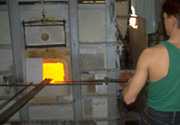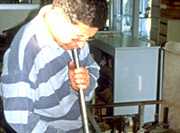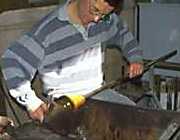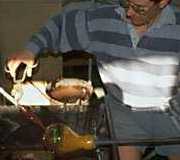Provence-Beyond (Beyond the French Riviera) ®
Also: [ Pottery | Santons | Biot ]
Below: [ Photos | Description ]
This series of photos was taken at the Verrerie d'Art Luzoro, in Biot.
Click on any photo for a larger view (13k-18k each).
[ Top | Photos | Description ]- The melt oven (four de fusion) holds enough melted glass, at 1100°C, for a week's work. The hollow iron rods (canne maitraisse) are resting with their ends preheating in the oven. The process starts when a ball of melted glass is taken from this oven on the end of the rod.
- The hot glass is blown, immediately after removing from the oven, to form a hollow globe.
- The globe of hot glass is rolled in different colors of powdered glass to give the basic colors. In this example, the bottom of the globe is being rolled in blue glass powder, just before the top half is rolled in yellow glass powder.
- The reheating oven, also maintained at 1100°C, is used to reheat the work in progress whenever necessary to maintain its pliability. On the right of the photo, a second, smaller lump of melted glass is being colored in preparation for use as a contrasting-color pattern.
- The globe of colored glass is rolled against a hollowed wooden form to give it its shape.
- An assistant hold a rod with the pattern-glass (being prepared in step 4), while the main glass globe is rotated to apply the desired pattern.
- The globe is blown a second time to give it the desired volume, with wooden form used as a guide.
- A second rod (pontil), with a lump of melted glass for glue, is attached to the bottom of the globe.
- The main rod is now removed, and the open end of the globe is shaped and finished off.
- Chloride fumes, in a well-ventelated enclosure, are used to give the work a matte finish.
- After removing the second rod (pontil), the still-hot but finished work is about to be put into the bake oven.
- The final bake oven, at a constant 500°C, brings the entire object to the same temperature. During the night, the oven is cooled gradually, over a period of 12 hours.











